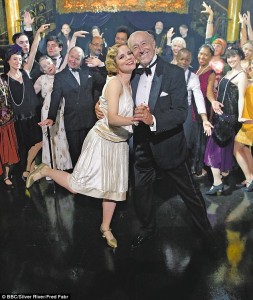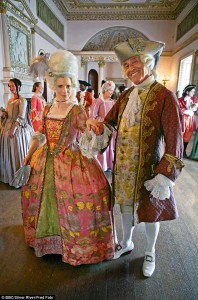Our new BBC4 series – on the history of dancing
 It’s an article for you from today’s Daily Mail, written by the excellent Mary Greene…
It’s an article for you from today’s Daily Mail, written by the excellent Mary Greene…
Gatsby and Daisy? No, it’s Lucy and Len, toes tapping, knees waggling, arms flapping. Everybody’s doing the Charleston today, including Len Goodman and Dr Lucy Worsley, unlikely partners in Dancing Cheek To Cheek, BBC4’s new history of British dance crazes – from the minuet and the polka to the waltz and the Turkey Trot.
It was here in the subterranean depths of London’s Café de Paris that the Charleston kicked off in 1925. Ma Meyrick’s louche 43 Club – immortalised by Evelyn Waugh as the fictional Old Hundredth – was just around the corner in Gerrard Street.
The war to end all wars was over and Bright Young Things sought escape from their loss and grief by dancing until they dropped. One couple famously danced the Charleston on the roof of a London taxi. This generation didn’t want to dance the way their old-fashioned Edwardian parents danced.
 Fortunately, TV historian Lucy, more usually seen showing us round a royal palace or riffling through Georgian wardrobes, is a natural flapper with her own signature 1920s bob – but even so, she’s been in make-up for hours having it crimped with vintage Marcel-clips.
Fortunately, TV historian Lucy, more usually seen showing us round a royal palace or riffling through Georgian wardrobes, is a natural flapper with her own signature 1920s bob – but even so, she’s been in make-up for hours having it crimped with vintage Marcel-clips.
She’s come very close to breaking her pre-nuptial agreement with her architect husband that she would never appear on Strictly Come Dancing. But this is history, so it doesn’t count. She’s had a few Charleston lessons from dancing master Darren Royston, who’s here to advise our plucky couple. ‘It’s my favourite dance,’ Lucy says. ‘I did it at school but I didn’t learn it correctly, my hands were going the wrong way. I’m nervous and I really want to do it well.’
So you’d think Strictly judge Len would have the advantage? Not really. Len usually dances the more restrained ballroom version of the Charleston, but today it’s the real thing. Many dance halls of the 1920s banned it or put up ‘PCQ’ signs: Please Charleston Quietly.
Pearls swinging, Lucy throws herself into it with gusto, poking out her tongue as she concentrates on the steps. ‘It’s really hard. It’s really fast,’ she says. No wonder flappers waved goodbye to their corsets. Her showstopper move is the Josephine Baker ‘scarecrow’ – all flailing arms – a Charleston step inspired by the famously uninhibited 1920s star of stage and screen.
But if Lucy’s having to concentrate on the Charleston, Len can’t get his head around some of the older dances in the series, which sees the pair trying out and demonstrating moves from the past. Now 70, he’s been dancing since he was 21, through an era 40-year-old Lucy probably thinks of as a post-war history syllabus. ‘I was young, good-looking, I had hair like a raven’s wing,’ he reminisces. ‘I started off jiving as a teenager and then I went to a ballroom class and, much to my shock and horror, I really enjoyed it. And that’s how I got into it.
‘I’ve struggled immensely with the 18th-century minuet though,’ he admits. ‘I couldn’t grasp the pattern of it. The two of you dance on your own with a circle of people watching you, probably mentally criticising. That’s the problem. It was truly a nerve-wracking display.’ Dance master Darren’s way of explaining the stately back-and-forth progression of a minuet was to imagine going along the bank of a river, then cutting across a bridge. ‘And I kept falling in and waiting for Lucy to rescue me and give me the kiss of life!’ Len says rather ruefully.
For the lower orders, dancing had been a carefree medieval courtship ritual until the Puritans came along in the mid-1600s and spoiled things.
Dances like the ‘cushion dance’ – in which a man holding a cushion begged a girl for a kiss when the music stopped – were flirty games, but 17th-century killjoys saw it as a prelude to going too far… and maybe they were right. In 1633 a couple were accused in the church court of having sex up against the village maypole; they hadn’t realised there was a bell on top and they inadvertently alerted the neighbours.
To righteous Puritans, dancing was the cause of ‘much dalliance, chambering, wantoness, whoredome and adultery’, not to mention ‘noysome lusts…’ Parliament banned maypoles in 1644.
A golden age of dancing was ushered in by the Restoration at the end of the 17th century. Now if you wanted to get on in society, you had to learn how to dance. Samuel Pepys engaged a dancing master for Mrs Pepys, then had a go himself. ‘The truth is, I think it a thing very useful for a gentleman,’ he wrote, then felt so consumed by ‘devilish jealousy’ at the dancing master’s attentions to his wife that he went upstairs to see if the bedclothes had been tossed – and checked to see that she was still wearing her drawers.
How things had changed by the beginning of the 18th century. To keep up socially you had to dance the minuet – the slow, stately, elegant dance that has caused Len so much trouble. After years of ballroom dancing, turning out his toes ballet-style doesn’t come naturally to him. He wasn’t the only one. ‘In the early 1700s, particularly in the English ballroom, there was a huge problem getting men to get up and dance the minuet, and watching Len you can see why,’ says dance historian Jennifer Thorp, who also contributes to the show.
Lucy, meanwhile, has to don a corset to maintain the correct posture for the minuet; now she’s strapped into tight-fitting stays with rigid boning to hold her in, rather than cross-lacing which was associated with loose morals as it was easier to undo.
No wonder that by the early 19th century dancers were ready to embrace something livelier – two new dance crazes that meant couples were whirling in each other’s arms, scandalously close. Lady Caroline Lamb was obsessed by waltzing until her lover Lord Byron, who had a club foot, made her promise to give it up. When he dumped her, she caused a scandal by slashing her wrists at a ball.
The waltz originated from boisterous Germanic folk dances, refined for the ballroom, and by mid-century the polka added a hop to it. It swept Europe. When it arrived in London in 1844, there was polkamania. Lucy takes to it rumbustiously.
‘She has to control that energy,’ shudders Darren. Fortunately, the Industrial Revolution introduced steelboned corsets that rein her in – and springy cage crinolines to give her some swirl.
‘I enjoyed the polka,’ says Len. ‘It wasn’t overly difficult but still a bit of fun.’
Len thinks Lucy has done pretty well for a novice. ‘For someone who’s never trained as a dancer, I think she’s done splendidly well. Dancers’ brains are all in their feet.’
From the 1890s to 1910s, the syncopated rhythm of Ragtime ushered in some very quirky dances: the Grizzly Bear, which involved hugging your partner tightly and stepping from side to side; the Turkey Trot (similar to the Grizzly Bear but with flapping arms) and the Camel Walk (a precursor of Michael Jackson’s Moonwalk). And then there was the Charleston.
At the Café de Paris the party is in full swing; sadly with fake cocktails. Lucy makes her grand entrance down the famous double staircase. Her bluestocking legs step, kick and do the monkey knees for her Charleston. Then, pausing to gather steam – and with a look of desperate trepidation – she jumps into Len’s arms for the grand finale. They film it again, and again, and again. Poor Len, debonair in his starched shirt but mopping his brow, looks ready to expire. ‘They’re abusing old people! Put that in the Daily Mail,’ he grumbles. He might not be a Bright Young Thing but he’s certainly a trouper.
‘Dancing Cheek to Cheek: An Intimate History of Dance’ begins on BBC Four, Monday 17th November, 9pm.






Looking forward to it.
Looking forward to it. Your murder series is on now in Canada. Loved the Jekyl and Hyde tryout 🙂
Wow this is so cool can’t wait to watch it!
Looking forward to it. You could be a guest judge on Strictly without breaking your pre-nup!
It looks delightful! This will be coming to our side of the pond one day, right? Right..?
It was a great program!
Kudos to Lucy for doing something that appears to be hard for her, out of her comfort zone!
I would just like to know where Lucy got the beautiful blue summer dress she is wearing. It is lovely!
I got it at Macy’s, Susan, in Boston last year. Best wishes from Lucy